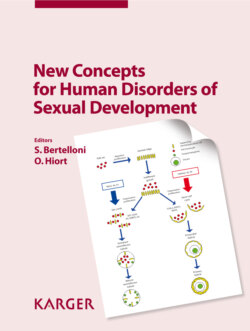Читать книгу New Concepts for Human Disorders of Sexual Development - Группа авторов - Страница 34
На сайте Литреса книга снята с продажи.
Spermatogenesis
ОглавлениеIn quantitative terms, spermatogenesis starts at puberty and is reflected by a rapidly increasing testicular volume, constituting the most common first sign of puberty in boys. Spermatogenesis is divided into 3 distinct but linked processes: mitotic self-renewal proliferation of spermatogonia, meiotic division of primary spermatocytes and non-proliferative maturation of round spermatids to spermatozoa (spermiogenesis). To investigate and visualise the different stages of spermatogenesis immunohistochemical staining with specific markers is an excellent method (see a list of suitable markers for humans in table 2). This production of mature fertile spermatozoa as the product of a functional spermatogenesis includes proliferation and differentiation of male germ cells starting with undifferentiated spermatogonia, also known as spermatogonial stem cells (SSCs). In contrast to the situation in rodents, whose germ cell populations can be categorised as Asingle, Apair, Aaligned, A1, A2, A3 and A4 [de Rooij and Grootegoed, 1998; de Rooij and Russell, 2000; Dettin et al. 2003], less different types of spermatogonia have been identified in primates: the Adark, the Apale, the Atransition and several types of B spermatogonia [Clermont, 1969; Meistrich and van Beek, 1993; Zhengwei et al., 1997; Ehmcke et al., 2005]. Among these cell subtypes, Adark spermatogonia are considered as reserve stem cells. This spermatogonial cell subtype does not divide when spermatogenesis is intact, but starts proliferating upon severe testicular damage [van Alphen et al., 1988; Ehmcke et al., 2005]. The Apale spermatogonia divide during every spermatogenic cycle and provide either self-renewing Apale spermatogonia or Atransition. After the last mitotic divisions, primary spermatocytes which are derived from B-spermatogonia enter meiosis. The first meiotic division starts with a long prophase and can be subdivided into 5 different stages: leptotene, zygotene, pachytene, diplotene, and diakinesis. Diakinesis ends with the migration of the chromosomes to the metaphase plate during metaphase I. During anaphase I, homologous chromosomes are separated, followed by telophase I where 2 daughter cells (secondary spermatocytes) are formed, each containing 1 of the 2 chromosomes from the homologous pair of chromosomes. After a short interkinesis, the second meiotic division starts with the metaphase II, followed by anaphase II and telophase II, which finally results in the formation of round haploid spermatids.
The formation of elongated spermatids during spermiogenesis is divided into 4 phases: the Golgi phase, the cap phase, the acrosome phase, and the maturation phase. Throughout the last phase, the nucleus condenses, histones are replaced by protamines, the remaining cytoplasm becomes the cytoplasmic droplet, and the mitochondria form a ring around the base of the flagellum. After completion of spermiogenesis, the immotile not fully differentiated testicular spermatozoa are transported by the peristaltic activity of the peritubular cells together with fluid excreted by Sertoli cells through the seminiferous tubules into the rete testis before entering the epididymis for final maturation.
The duration of spermatogenesis and spermiogenesis takes approximately 34 days in mice and, including the proliferation of spermatogonia, around 74 days in humans [Oakberg, 1957; Heller and Clermont, 1963, 1964; Amann, 2008].
